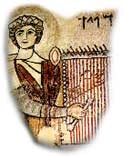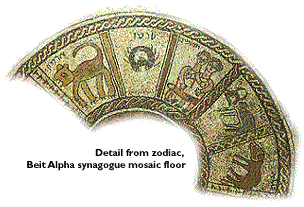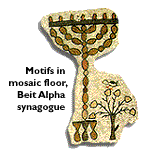

Introduction
With roots during the Second Temple period, the synagogue during late
antiquity became the most important institution in Jewish life. Fine
synagogue buildings were constructed throughout the Land of Israel that
reflected the religious lives of the Jews who built them. The destruction
of the Jerusalem Temple in 70 CE and the removal of the center of Jewish
life to the Galilee were pivotal for the history of Jewish art and architecture.
The strictly aniconic and non-symbolic art of the Second Temple period
gave way to a more open and varied approach to art from the third century
onward. The decline of paganism and the rise and expansion of Christianity
most certainly influenced the Jewish attitude toward art. The art and
architecture of the ancient synagogues set in stone the beliefs, aspirations,
customs and traditions of the Jews in their land at the very time when
the literature of the Rabbinic Sages was being written and edited.
Interpreting
the Second Commandment
 Throughout
the nineteenth century, scholars were convinced that the Jews as a people
were artistically deprived. There were scholars[1] who
assumed that the Galilean-type synagogues were built by the Roman authorities
for the Jews, who certainly would (or could) not build these
fine structures on their own. During this period, it was often said,
the Jewish "genius" was expressed through the Word, not through the
image. The source of this Jewish lack was thought to have been the Second
Commandment: "You shall not make for yourself a sculptured image, or
any likeness of what is in the heavens above, or on the earth below,
or in the waters under the earth. You shall not bow down to them or
serve them..."[2] Throughout
the nineteenth century, scholars were convinced that the Jews as a people
were artistically deprived. There were scholars[1] who
assumed that the Galilean-type synagogues were built by the Roman authorities
for the Jews, who certainly would (or could) not build these
fine structures on their own. During this period, it was often said,
the Jewish "genius" was expressed through the Word, not through the
image. The source of this Jewish lack was thought to have been the Second
Commandment: "You shall not make for yourself a sculptured image, or
any likeness of what is in the heavens above, or on the earth below,
or in the waters under the earth. You shall not bow down to them or
serve them..."[2]

In fact, these verses are open to interpretation. It may be read strictly
as a prohibition against all images. Alternatively, the Second Commandment
may be seen as restricting images when there is fear that "you shall
not bow down to them or serve them." Other sorts of images, then, may
be permitted. These two interpretations set the contours of Jewish
attitudes
toward art from antiquity in to the modern period.
Jewish art of the latter Second Temple, for example, seems to have functioned
under a strict and widely held interpretation of the Second Commandment.
Artistic creations from this period are characterized by their focus
upon geometric and floral patterns. The situation changes radically
from the third century: A broad repertoire of images appear within Jewish
contexts, including both Jewish symbols and blatantly pagan images.
Discovery of the synagogues of Naaran, Beit Alpha, the necropolis of
Beit Sheraim, and, most important, the synagogue of Dura Europos in
Syria, has provided evidence that Jews during late antiquity often interpreted
the Second Commandment in a more liberal manner.
Although there is a marked liberalization from the third century, attitudes
in regard to Jewish art within the Rabbinic community remained mixed.
Some Sages were vehemently against art, even refusing to look upon
the
image of the emperor on a coin. Others considered it to be relatively
harmless. A statement in the Jerusalem Talmud (preserved in its entirety
only in a manuscript discovered in the Cairo Geniza) reflects a more
tolerant, if somewhat ambivalent position: "In the days of Rabbi Johanan
they permitted images [tzayirin] on its walls, and he did not
stop them. In the days of R. Abun they permitted images on mosaics,
and he did not stop them."[3]
Mosaic floors in ancient synagogues
Six ancient synagogue mosaics containing images of the zodiac have been
discovered in Israel. These pavements date from the fourth to the sixth
century and include Hammat Tiberias, Beit Alpha, Huseifa, Susiya, Naaran,
and the recently discovered mosaic at Sepphoris. The zodiac was adapted
from pagan art to represent the yearly calendrical cycle. This is made
explicit at Sepphoris, where both the zodiac signs and personifications
of the months are illustrated. In the Jewish calendar the months follow
the signs exactly. The images of the sun god symbolizes the day; the
background of the crescent moon and stars represent the night. Thus,
the zodiac calendar was employed as a significant framework for the
annual synagogue rituals. This recurrence of the zodiac designs in a
number of synagogue mosaics indicates its relevance to religious thought
and its importance in synagogue rituals.

During the mid-sixth
century CE synagogue art in the Jordan Rift Valley and in Judea seems
to have taken an aniconic turn, as evident, for instance, at Ein-Gedi.
Here no figurative zodiac appears on the synagogue floor, rather, a list
of the zodiac signs appears in a floor inscription. At Khirbet Susiya,
Biblical scenes and the zodiac are replaced by a floral and geometric
carpet. In other late-sixth century synagogues, too, the design now consists
of floral and geometric carpets (Jericho, Maoz Hayyim, and Ein-Gedi).
The menorah, by far the most important and widespread Jewish symbol during
this period, was also integrated into the decorated synagogue pavement.
That the religious conception of the Beit Alpha community was considerably
more liberal than that of the communities mentioned above is reflected
in the way it decorated its synagogue. In marked contrast to the synagogues
mentioned above, the well-preserved mosaic floor of the Beit Alpha synagogue[4]
makes use of the human figure in depicting the binding of Isaac as well
the zodiac cycle, and also includes an iconographic program with the Ark
of the Scrolls, the Menorah and ritual objects.
The most common Jewish symbols depicted on synagogue mosaic pavements
in the Land of Israel during late antiquity were the menorah, the Torah
Shrine, ritual appurtenances such as the lulav and etrog,
the shofar, and the incense shovel, symbols derived from the symbolism
of the Jerusalem Temple. Another common symbol was the conch, which appears
in synagogue art in the form of a stylized scallop ornamentation with
other motifs. The biblical themes were selected from a relatively small
number of biblical stories: the Sacrifice of Isaac, Noah's ark, King David,
and Daniel in the lions' den. The limited range of symbols and subjects
selected by the Jewish community and its donors leads us to believe that
designs may have been chosen from available pattern books.
|
[1]
Kohl and Watzinger. This attitude was expressed even in so thoroughly Jewish
a publication as The Jewish Encyclopedia in 1902. [Back]
[2] Exod. 20:4-5 [Back]
[3] Jerusalem Talmud, Avodah Zarah, 3:3, 42d, according
to a Genizah fragment in the Antonin Library, St. Petersburg. [Back]
[4] An inscription states that Marianos and his son
Hanina made this floor during the reign of Emperor Justinian (either
Justinian I [518-527] or Justinian II [527-565]). [Back] |
|